Management Accounting: Systems, Methods, and Financial Analysis
VerifiedAdded on 2023/01/11
|26
|6041
|69
Report
AI Summary
This report delves into the realm of management accounting, focusing on its application within Apple Inc. It begins by defining management accounting and outlining the essential requirements of various systems, including cost accounting, inventory management, and price optimization. The report then explores different methods used for management accounting reporting, such as cost reports. Furthermore, it examines the application of management accounting techniques, including income statements using both absorption and marginal costing. The report also analyzes planning tools utilized in budgetary control, discussing their advantages and disadvantages. It assesses how organizations adapt management accounting systems to address financial problems and explores how these systems can contribute to sustainable success. The report concludes with an evaluation of planning tools in resolving financial issues to lead an entity to sustainable successes.
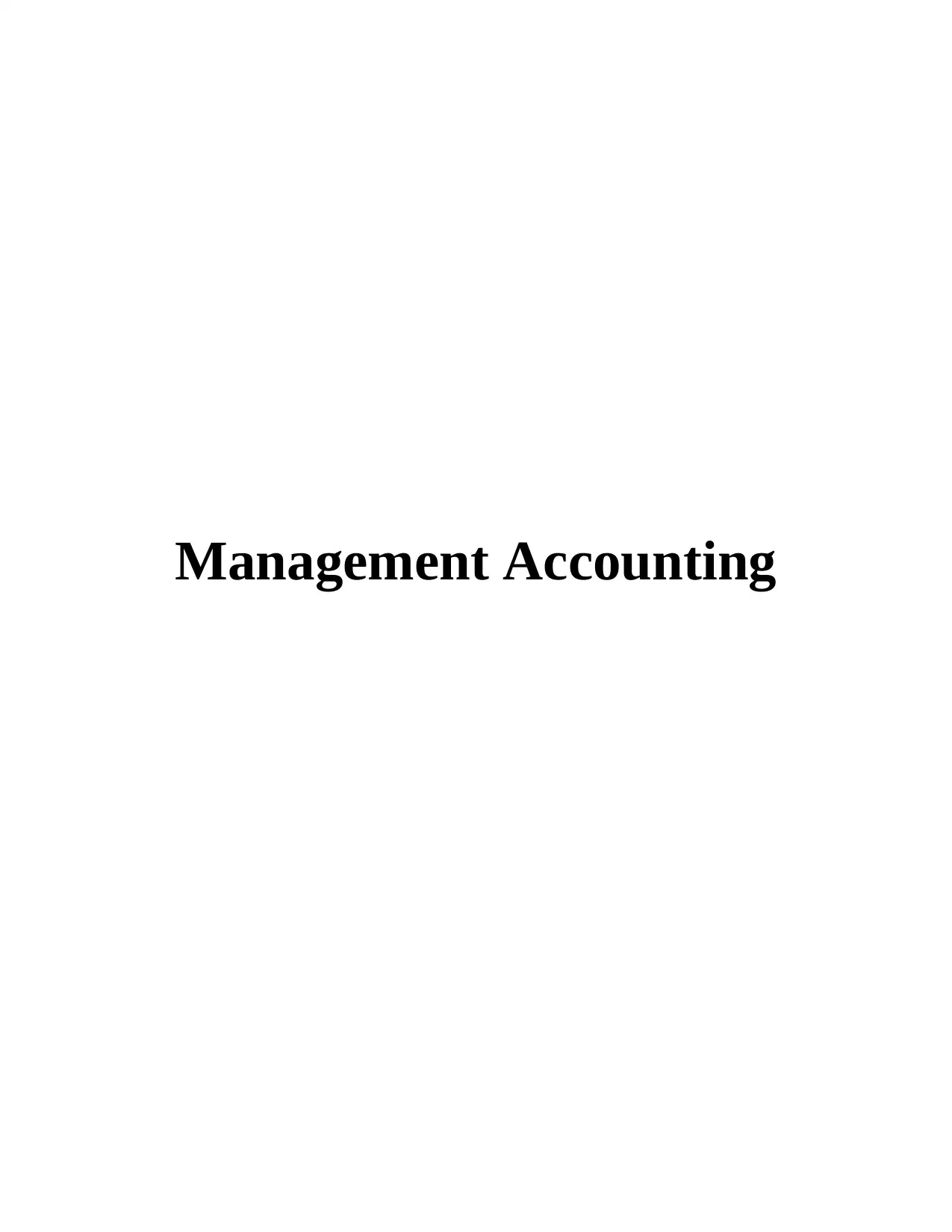
Management Accounting
Paraphrase This Document
Need a fresh take? Get an instant paraphrase of this document with our AI Paraphraser
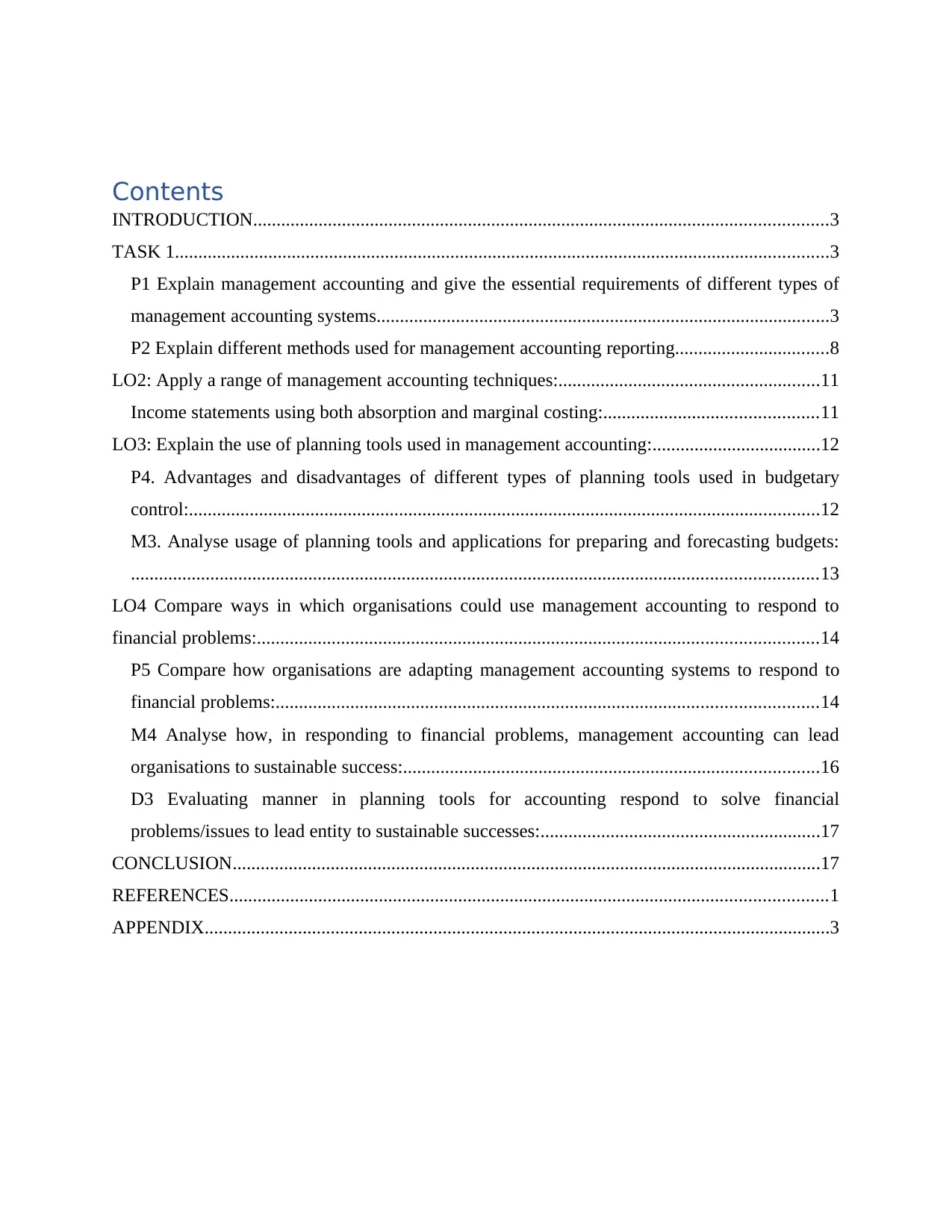
Contents
INTRODUCTION...........................................................................................................................3
TASK 1............................................................................................................................................3
P1 Explain management accounting and give the essential requirements of different types of
management accounting systems.................................................................................................3
P2 Explain different methods used for management accounting reporting.................................8
LO2: Apply a range of management accounting techniques:........................................................11
Income statements using both absorption and marginal costing:..............................................11
LO3: Explain the use of planning tools used in management accounting:....................................12
P4. Advantages and disadvantages of different types of planning tools used in budgetary
control:.......................................................................................................................................12
M3. Analyse usage of planning tools and applications for preparing and forecasting budgets:
...................................................................................................................................................13
LO4 Compare ways in which organisations could use management accounting to respond to
financial problems:........................................................................................................................14
P5 Compare how organisations are adapting management accounting systems to respond to
financial problems:....................................................................................................................14
M4 Analyse how, in responding to financial problems, management accounting can lead
organisations to sustainable success:.........................................................................................16
D3 Evaluating manner in planning tools for accounting respond to solve financial
problems/issues to lead entity to sustainable successes:............................................................17
CONCLUSION..............................................................................................................................17
REFERENCES................................................................................................................................1
APPENDIX......................................................................................................................................3
INTRODUCTION...........................................................................................................................3
TASK 1............................................................................................................................................3
P1 Explain management accounting and give the essential requirements of different types of
management accounting systems.................................................................................................3
P2 Explain different methods used for management accounting reporting.................................8
LO2: Apply a range of management accounting techniques:........................................................11
Income statements using both absorption and marginal costing:..............................................11
LO3: Explain the use of planning tools used in management accounting:....................................12
P4. Advantages and disadvantages of different types of planning tools used in budgetary
control:.......................................................................................................................................12
M3. Analyse usage of planning tools and applications for preparing and forecasting budgets:
...................................................................................................................................................13
LO4 Compare ways in which organisations could use management accounting to respond to
financial problems:........................................................................................................................14
P5 Compare how organisations are adapting management accounting systems to respond to
financial problems:....................................................................................................................14
M4 Analyse how, in responding to financial problems, management accounting can lead
organisations to sustainable success:.........................................................................................16
D3 Evaluating manner in planning tools for accounting respond to solve financial
problems/issues to lead entity to sustainable successes:............................................................17
CONCLUSION..............................................................................................................................17
REFERENCES................................................................................................................................1
APPENDIX......................................................................................................................................3

INTRODUCTION
Management accounting can be defined as the use of information prepared by the financial
department by the managers of an organisation to take a better and informed decision for the
company (Ward, 2012). Apple is an American multinational company which deals with
manufacturing of technology such as computers, mobiles, music devices etcetera. It was founded
in the year 1976 and is headquartered in California, United States. It can be argued that this
decade has witnessed one of the biggest waves of technological changes and Apple is certainly
one of the big five technology company in the world. In the following project report, an attempt
has been made to identify and evaluate the role and essential requirements of different types of
management accounting systems and also determine the various methods used for management
accounting reporting. The report also aims to identify the methods of costing such as marginal
and absorption costing. In the report, various types of planning tools which are being used for
budgetary control and being analysed for their advantages and disadvantages. At last, the report
aims to compare how different organisations are using management accounting systems for
responding to various financial problems as well.
TASK 1
P1 Explain management accounting and give the essential requirements of different types of
management accounting systems.
Management accounting can be defined as the process of measuring, identification,
determination, communication and analysis of financial statements and financial information by
the managers of an organisation to take better decisions related to day-to-day business activities
and operations (Otley, 2016). In the context of Apple Inc., management accounting can be
defined as the managerial process of interpreting the financial information related to the
company’s operations which assists in taking better decisions and improving the productivity and
profitability of the company as a whole. One of the major point of practical difference between
the principles of management accounting and traditional accounting is that the statement
prepared with the help of traditional accounting are used by the multiple stakeholders of the
company such as customers, shareholders or suppliers to form judgment about the profitability
and financial position of the company whereas management accounting reports are used
internally by the managers to take better decisions. Financial accounting is done at a particular
Management accounting can be defined as the use of information prepared by the financial
department by the managers of an organisation to take a better and informed decision for the
company (Ward, 2012). Apple is an American multinational company which deals with
manufacturing of technology such as computers, mobiles, music devices etcetera. It was founded
in the year 1976 and is headquartered in California, United States. It can be argued that this
decade has witnessed one of the biggest waves of technological changes and Apple is certainly
one of the big five technology company in the world. In the following project report, an attempt
has been made to identify and evaluate the role and essential requirements of different types of
management accounting systems and also determine the various methods used for management
accounting reporting. The report also aims to identify the methods of costing such as marginal
and absorption costing. In the report, various types of planning tools which are being used for
budgetary control and being analysed for their advantages and disadvantages. At last, the report
aims to compare how different organisations are using management accounting systems for
responding to various financial problems as well.
TASK 1
P1 Explain management accounting and give the essential requirements of different types of
management accounting systems.
Management accounting can be defined as the process of measuring, identification,
determination, communication and analysis of financial statements and financial information by
the managers of an organisation to take better decisions related to day-to-day business activities
and operations (Otley, 2016). In the context of Apple Inc., management accounting can be
defined as the managerial process of interpreting the financial information related to the
company’s operations which assists in taking better decisions and improving the productivity and
profitability of the company as a whole. One of the major point of practical difference between
the principles of management accounting and traditional accounting is that the statement
prepared with the help of traditional accounting are used by the multiple stakeholders of the
company such as customers, shareholders or suppliers to form judgment about the profitability
and financial position of the company whereas management accounting reports are used
internally by the managers to take better decisions. Financial accounting is done at a particular
⊘ This is a preview!⊘
Do you want full access?
Subscribe today to unlock all pages.

Trusted by 1+ million students worldwide
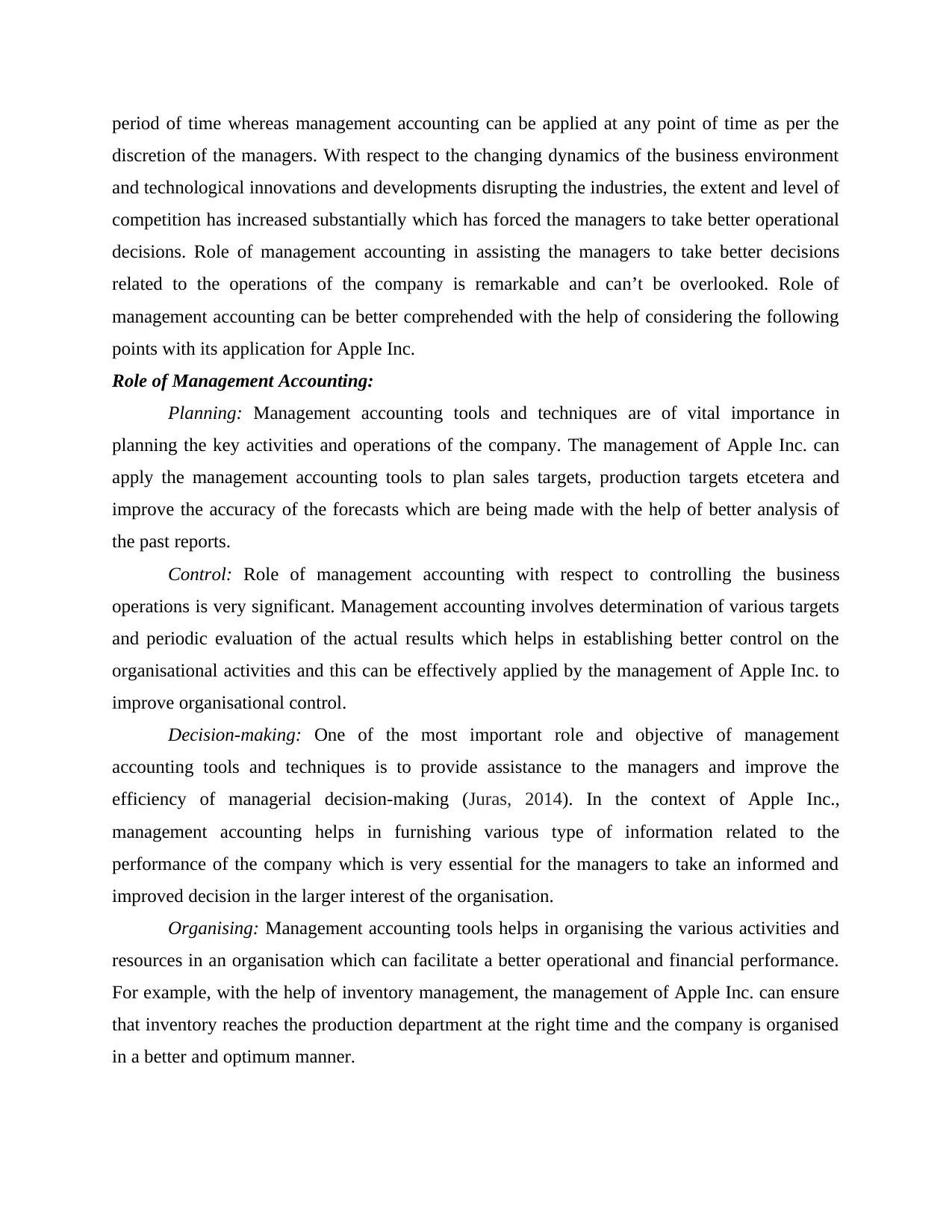
period of time whereas management accounting can be applied at any point of time as per the
discretion of the managers. With respect to the changing dynamics of the business environment
and technological innovations and developments disrupting the industries, the extent and level of
competition has increased substantially which has forced the managers to take better operational
decisions. Role of management accounting in assisting the managers to take better decisions
related to the operations of the company is remarkable and can’t be overlooked. Role of
management accounting can be better comprehended with the help of considering the following
points with its application for Apple Inc.
Role of Management Accounting:
Planning: Management accounting tools and techniques are of vital importance in
planning the key activities and operations of the company. The management of Apple Inc. can
apply the management accounting tools to plan sales targets, production targets etcetera and
improve the accuracy of the forecasts which are being made with the help of better analysis of
the past reports.
Control: Role of management accounting with respect to controlling the business
operations is very significant. Management accounting involves determination of various targets
and periodic evaluation of the actual results which helps in establishing better control on the
organisational activities and this can be effectively applied by the management of Apple Inc. to
improve organisational control.
Decision-making: One of the most important role and objective of management
accounting tools and techniques is to provide assistance to the managers and improve the
efficiency of managerial decision-making (Juras, 2014). In the context of Apple Inc.,
management accounting helps in furnishing various type of information related to the
performance of the company which is very essential for the managers to take an informed and
improved decision in the larger interest of the organisation.
Organising: Management accounting tools helps in organising the various activities and
resources in an organisation which can facilitate a better operational and financial performance.
For example, with the help of inventory management, the management of Apple Inc. can ensure
that inventory reaches the production department at the right time and the company is organised
in a better and optimum manner.
discretion of the managers. With respect to the changing dynamics of the business environment
and technological innovations and developments disrupting the industries, the extent and level of
competition has increased substantially which has forced the managers to take better operational
decisions. Role of management accounting in assisting the managers to take better decisions
related to the operations of the company is remarkable and can’t be overlooked. Role of
management accounting can be better comprehended with the help of considering the following
points with its application for Apple Inc.
Role of Management Accounting:
Planning: Management accounting tools and techniques are of vital importance in
planning the key activities and operations of the company. The management of Apple Inc. can
apply the management accounting tools to plan sales targets, production targets etcetera and
improve the accuracy of the forecasts which are being made with the help of better analysis of
the past reports.
Control: Role of management accounting with respect to controlling the business
operations is very significant. Management accounting involves determination of various targets
and periodic evaluation of the actual results which helps in establishing better control on the
organisational activities and this can be effectively applied by the management of Apple Inc. to
improve organisational control.
Decision-making: One of the most important role and objective of management
accounting tools and techniques is to provide assistance to the managers and improve the
efficiency of managerial decision-making (Juras, 2014). In the context of Apple Inc.,
management accounting helps in furnishing various type of information related to the
performance of the company which is very essential for the managers to take an informed and
improved decision in the larger interest of the organisation.
Organising: Management accounting tools helps in organising the various activities and
resources in an organisation which can facilitate a better operational and financial performance.
For example, with the help of inventory management, the management of Apple Inc. can ensure
that inventory reaches the production department at the right time and the company is organised
in a better and optimum manner.
Paraphrase This Document
Need a fresh take? Get an instant paraphrase of this document with our AI Paraphraser

Directing: Tools of management accounting can be used to provide direction to the
employees and the workforce of an organisation which is a very important role. For example,
cost accounting helps the manager to identify areas of production where an improvement is
necessary and essential guidelines and directions are provided which can help the employees to
reduce the production costs and act in a desirable manner.
Performance Evaluation: Performance evaluation refers to the comparison of actual
performance of the employees and various organisational departments with the standard or
budgeted performance levels (Ter Bogt and Van Helden, 2012). Role of management accounting
in performance evaluation is essential as it provides various reports which forms the basis of
comparison. In the context of Apple Inc., management accounting reports such as performance
reports and cost sheets helps in evaluation of the efficiency of various operational performance
dimensions of the company.
Types of Management Accounting Systems:
Cost-accounting systems:
Cost-accounting systems is a managerial approach of determination and estimation of the
total cost incurred in the various stages of production and manufacturing of products and services
and is vital for many other concepts such as valuation of the inventory, determining the
profitability etcetera (Drury, 2013). Under cost accounting, managers of an organisation try to
determine the areas of cost where there exists a scope of improvement and any unusual change
can be easily identified with the help of costing systems. Costing systems can be done by using
either the marginal cost approach or the absorption cost approach and profit under both the
methods can be calculated. In the context of Apple Inc., cost accounting as a tool of management
accounting is of vital importance in helping the company to control the various costs and
expenses involves in the production and monitor effectively to improve the profitability of the
operations.
Inventory management systems:
Inventory management systems as a tool of management accounting involves
determination of an economic order quantity at which the cost of inventory such as storage costs,
carrying costs, ordering costs etcetera is minimum for the company (Muller, 2019). It helps the
company to enhance the smooth production process and determine the point at which inventory
should arrive so that the cost related to inventory is minimum and situations of understock and
employees and the workforce of an organisation which is a very important role. For example,
cost accounting helps the manager to identify areas of production where an improvement is
necessary and essential guidelines and directions are provided which can help the employees to
reduce the production costs and act in a desirable manner.
Performance Evaluation: Performance evaluation refers to the comparison of actual
performance of the employees and various organisational departments with the standard or
budgeted performance levels (Ter Bogt and Van Helden, 2012). Role of management accounting
in performance evaluation is essential as it provides various reports which forms the basis of
comparison. In the context of Apple Inc., management accounting reports such as performance
reports and cost sheets helps in evaluation of the efficiency of various operational performance
dimensions of the company.
Types of Management Accounting Systems:
Cost-accounting systems:
Cost-accounting systems is a managerial approach of determination and estimation of the
total cost incurred in the various stages of production and manufacturing of products and services
and is vital for many other concepts such as valuation of the inventory, determining the
profitability etcetera (Drury, 2013). Under cost accounting, managers of an organisation try to
determine the areas of cost where there exists a scope of improvement and any unusual change
can be easily identified with the help of costing systems. Costing systems can be done by using
either the marginal cost approach or the absorption cost approach and profit under both the
methods can be calculated. In the context of Apple Inc., cost accounting as a tool of management
accounting is of vital importance in helping the company to control the various costs and
expenses involves in the production and monitor effectively to improve the profitability of the
operations.
Inventory management systems:
Inventory management systems as a tool of management accounting involves
determination of an economic order quantity at which the cost of inventory such as storage costs,
carrying costs, ordering costs etcetera is minimum for the company (Muller, 2019). It helps the
company to enhance the smooth production process and determine the point at which inventory
should arrive so that the cost related to inventory is minimum and situations of understock and

overstock are also avoided. The management of Apple Inc. can improve the bottom-line of the
company and achieve optimum utilisation of resources with the help of effective inventory
management systems in the company.
Price-optimisation systems:
Price optimisation system is one of the most important and vital tool of management
accounting which is primarily based on the application of statistical and mathematical models to
analyse and determine the behaviour of consumer with respect to different prices of a product
and subsequently helps in determination of a price level which is best suited for the company to
accomplish its long-term goals and targets (Ito and Fujimaki, 2017). Price optimisation models is
of vital importance for the management of Apple Inc. because of the high extent of competition
and making accurate forecasts for demand which forms the basis of production and sales targets.
Job-costing systems:
Job costing system as a tool of Management accounting is vital importance for
organisations where products are manufactured in batches and are of different types and nature.
Contract costing is a best example of implementation of job costing methods. It helps in
determination of profitability of various contracts and also provides essential information to fill
tenders. Job costing data can be used in contracts where some part of the cost is to be refunded.
Management Information Systems:
Management Information Systems refer to a network of shared computer systems and
software’s which is implemented and installed in an organisation and has great importance for
any company (Laudon and Laudon, 2015). MIS systems have the primary objective of obtaining
data from various departments of the company are provide this data to the managers which can
help in taking better operational decisions. In the context of Apple Inc., MIS system can help the
managers in maintaining a central system where information as per the wish of managers can be
easily obtained and utilised.
Essential Requirements of Different Types of Management Accounting Systems:
Accuracy: Information which is necessary for the management accounting system should
be accurate and complete. Any element of ambiguity or uncertainty in the management
accounting information leads to an ineffective implementation of the whole process which is not
desirable by the management of Apple Inc.
company and achieve optimum utilisation of resources with the help of effective inventory
management systems in the company.
Price-optimisation systems:
Price optimisation system is one of the most important and vital tool of management
accounting which is primarily based on the application of statistical and mathematical models to
analyse and determine the behaviour of consumer with respect to different prices of a product
and subsequently helps in determination of a price level which is best suited for the company to
accomplish its long-term goals and targets (Ito and Fujimaki, 2017). Price optimisation models is
of vital importance for the management of Apple Inc. because of the high extent of competition
and making accurate forecasts for demand which forms the basis of production and sales targets.
Job-costing systems:
Job costing system as a tool of Management accounting is vital importance for
organisations where products are manufactured in batches and are of different types and nature.
Contract costing is a best example of implementation of job costing methods. It helps in
determination of profitability of various contracts and also provides essential information to fill
tenders. Job costing data can be used in contracts where some part of the cost is to be refunded.
Management Information Systems:
Management Information Systems refer to a network of shared computer systems and
software’s which is implemented and installed in an organisation and has great importance for
any company (Laudon and Laudon, 2015). MIS systems have the primary objective of obtaining
data from various departments of the company are provide this data to the managers which can
help in taking better operational decisions. In the context of Apple Inc., MIS system can help the
managers in maintaining a central system where information as per the wish of managers can be
easily obtained and utilised.
Essential Requirements of Different Types of Management Accounting Systems:
Accuracy: Information which is necessary for the management accounting system should
be accurate and complete. Any element of ambiguity or uncertainty in the management
accounting information leads to an ineffective implementation of the whole process which is not
desirable by the management of Apple Inc.
⊘ This is a preview!⊘
Do you want full access?
Subscribe today to unlock all pages.

Trusted by 1+ million students worldwide
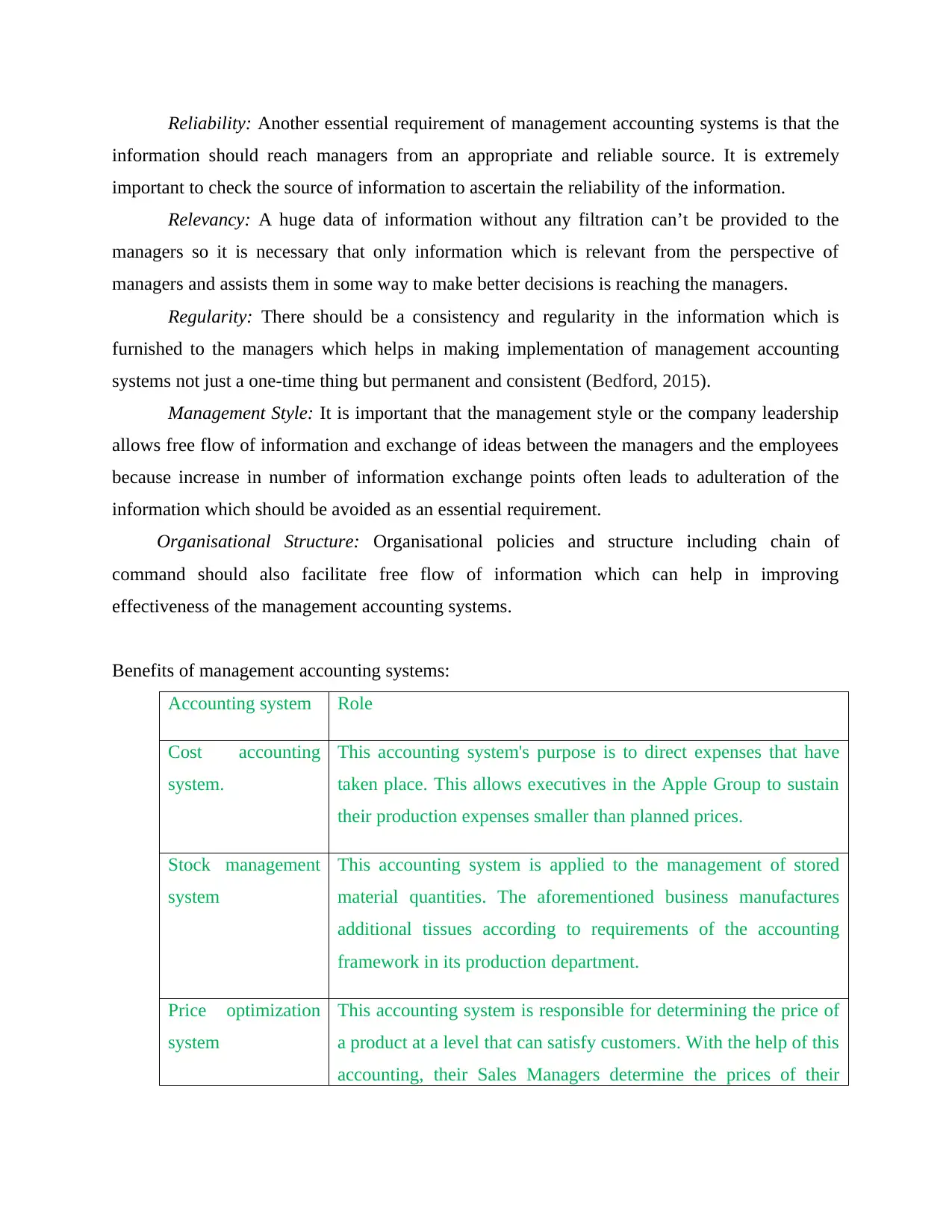
Reliability: Another essential requirement of management accounting systems is that the
information should reach managers from an appropriate and reliable source. It is extremely
important to check the source of information to ascertain the reliability of the information.
Relevancy: A huge data of information without any filtration can’t be provided to the
managers so it is necessary that only information which is relevant from the perspective of
managers and assists them in some way to make better decisions is reaching the managers.
Regularity: There should be a consistency and regularity in the information which is
furnished to the managers which helps in making implementation of management accounting
systems not just a one-time thing but permanent and consistent (Bedford, 2015).
Management Style: It is important that the management style or the company leadership
allows free flow of information and exchange of ideas between the managers and the employees
because increase in number of information exchange points often leads to adulteration of the
information which should be avoided as an essential requirement.
Organisational Structure: Organisational policies and structure including chain of
command should also facilitate free flow of information which can help in improving
effectiveness of the management accounting systems.
Benefits of management accounting systems:
Accounting system Role
Cost accounting
system.
This accounting system's purpose is to direct expenses that have
taken place. This allows executives in the Apple Group to sustain
their production expenses smaller than planned prices.
Stock management
system
This accounting system is applied to the management of stored
material quantities. The aforementioned business manufactures
additional tissues according to requirements of the accounting
framework in its production department.
Price optimization
system
This accounting system is responsible for determining the price of
a product at a level that can satisfy customers. With the help of this
accounting, their Sales Managers determine the prices of their
information should reach managers from an appropriate and reliable source. It is extremely
important to check the source of information to ascertain the reliability of the information.
Relevancy: A huge data of information without any filtration can’t be provided to the
managers so it is necessary that only information which is relevant from the perspective of
managers and assists them in some way to make better decisions is reaching the managers.
Regularity: There should be a consistency and regularity in the information which is
furnished to the managers which helps in making implementation of management accounting
systems not just a one-time thing but permanent and consistent (Bedford, 2015).
Management Style: It is important that the management style or the company leadership
allows free flow of information and exchange of ideas between the managers and the employees
because increase in number of information exchange points often leads to adulteration of the
information which should be avoided as an essential requirement.
Organisational Structure: Organisational policies and structure including chain of
command should also facilitate free flow of information which can help in improving
effectiveness of the management accounting systems.
Benefits of management accounting systems:
Accounting system Role
Cost accounting
system.
This accounting system's purpose is to direct expenses that have
taken place. This allows executives in the Apple Group to sustain
their production expenses smaller than planned prices.
Stock management
system
This accounting system is applied to the management of stored
material quantities. The aforementioned business manufactures
additional tissues according to requirements of the accounting
framework in its production department.
Price optimization
system
This accounting system is responsible for determining the price of
a product at a level that can satisfy customers. With the help of this
accounting, their Sales Managers determine the prices of their
Paraphrase This Document
Need a fresh take? Get an instant paraphrase of this document with our AI Paraphraser
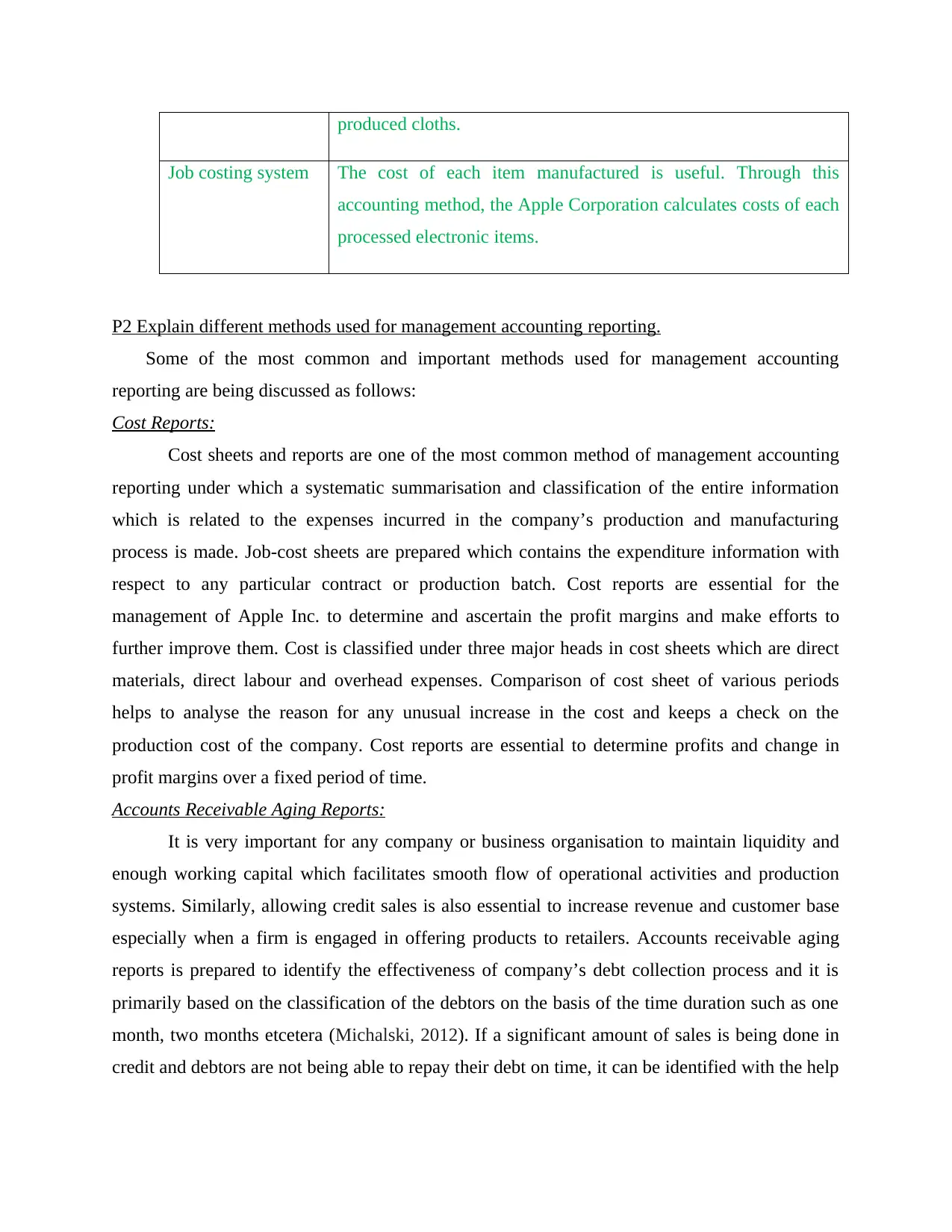
produced cloths.
Job costing system The cost of each item manufactured is useful. Through this
accounting method, the Apple Corporation calculates costs of each
processed electronic items.
P2 Explain different methods used for management accounting reporting.
Some of the most common and important methods used for management accounting
reporting are being discussed as follows:
Cost Reports:
Cost sheets and reports are one of the most common method of management accounting
reporting under which a systematic summarisation and classification of the entire information
which is related to the expenses incurred in the company’s production and manufacturing
process is made. Job-cost sheets are prepared which contains the expenditure information with
respect to any particular contract or production batch. Cost reports are essential for the
management of Apple Inc. to determine and ascertain the profit margins and make efforts to
further improve them. Cost is classified under three major heads in cost sheets which are direct
materials, direct labour and overhead expenses. Comparison of cost sheet of various periods
helps to analyse the reason for any unusual increase in the cost and keeps a check on the
production cost of the company. Cost reports are essential to determine profits and change in
profit margins over a fixed period of time.
Accounts Receivable Aging Reports:
It is very important for any company or business organisation to maintain liquidity and
enough working capital which facilitates smooth flow of operational activities and production
systems. Similarly, allowing credit sales is also essential to increase revenue and customer base
especially when a firm is engaged in offering products to retailers. Accounts receivable aging
reports is prepared to identify the effectiveness of company’s debt collection process and it is
primarily based on the classification of the debtors on the basis of the time duration such as one
month, two months etcetera (Michalski, 2012). If a significant amount of sales is being done in
credit and debtors are not being able to repay their debt on time, it can be identified with the help
Job costing system The cost of each item manufactured is useful. Through this
accounting method, the Apple Corporation calculates costs of each
processed electronic items.
P2 Explain different methods used for management accounting reporting.
Some of the most common and important methods used for management accounting
reporting are being discussed as follows:
Cost Reports:
Cost sheets and reports are one of the most common method of management accounting
reporting under which a systematic summarisation and classification of the entire information
which is related to the expenses incurred in the company’s production and manufacturing
process is made. Job-cost sheets are prepared which contains the expenditure information with
respect to any particular contract or production batch. Cost reports are essential for the
management of Apple Inc. to determine and ascertain the profit margins and make efforts to
further improve them. Cost is classified under three major heads in cost sheets which are direct
materials, direct labour and overhead expenses. Comparison of cost sheet of various periods
helps to analyse the reason for any unusual increase in the cost and keeps a check on the
production cost of the company. Cost reports are essential to determine profits and change in
profit margins over a fixed period of time.
Accounts Receivable Aging Reports:
It is very important for any company or business organisation to maintain liquidity and
enough working capital which facilitates smooth flow of operational activities and production
systems. Similarly, allowing credit sales is also essential to increase revenue and customer base
especially when a firm is engaged in offering products to retailers. Accounts receivable aging
reports is prepared to identify the effectiveness of company’s debt collection process and it is
primarily based on the classification of the debtors on the basis of the time duration such as one
month, two months etcetera (Michalski, 2012). If a significant amount of sales is being done in
credit and debtors are not being able to repay their debt on time, it can be identified with the help

of these reports by the management of Apple Inc. and demonstrates a need to change the
company’s debt policies.
Performance Reports:
Performance reports is one of the most essential method of management accounting
reporting which helps in comparison of the budgeted or expected or standard performance with
the actual performance (Melitski and Manoharan, 2014). Performance reports in an organisation
are prepared for the various departments such as production, sales, finance, marketing, human
resource etcetera. Moreover, performance reports are also prepared for all the employees and
members of the organisation which helps the management of Apple Inc. to take measures and
steps which can lead to an improvement in operational efficiency and productivity.
Sales Reports:
Sales reports can be defined as the information provided to the managers with respect to
various sales accruing to different period of time. It is of crucial importance for the management
of Apple Inc. as it helps in improving the forecasts which are made for future sales and also
helps in evaluation of the effectiveness of current marketing and selling strategies. Sales report
of different period can be compared to ascertain the effectiveness of any marketing strategy or
sales plan which can be used for future also. Sales report are also very essential for making
accurate forecasts and prepare the production budgets.
Variance Reports:
Variance Reports are of utmost importance and significance and provide vital
information to the management with respect to the variances between actual results or outcomes
and budgeted results or targets. It clearly identifies the deviations and helps the managers to take
corrective actions or measure. Variance reports are usually made for identification of the
deviation between expected financial outcomes and actual financial outcomes for a fixed period
of time by the management of Apple Inc. However, with the increasing level of competition and
the need to take competitive edge, variance reports are now being prepared for each department
and function of the organisation so that the company can improve the overall operational
productivity and performance.
Profit Reports:
Profit reports are another important method of management accounting reporting as profit
is the main motive for any organisation with encourages it to continue its operations in the
company’s debt policies.
Performance Reports:
Performance reports is one of the most essential method of management accounting
reporting which helps in comparison of the budgeted or expected or standard performance with
the actual performance (Melitski and Manoharan, 2014). Performance reports in an organisation
are prepared for the various departments such as production, sales, finance, marketing, human
resource etcetera. Moreover, performance reports are also prepared for all the employees and
members of the organisation which helps the management of Apple Inc. to take measures and
steps which can lead to an improvement in operational efficiency and productivity.
Sales Reports:
Sales reports can be defined as the information provided to the managers with respect to
various sales accruing to different period of time. It is of crucial importance for the management
of Apple Inc. as it helps in improving the forecasts which are made for future sales and also
helps in evaluation of the effectiveness of current marketing and selling strategies. Sales report
of different period can be compared to ascertain the effectiveness of any marketing strategy or
sales plan which can be used for future also. Sales report are also very essential for making
accurate forecasts and prepare the production budgets.
Variance Reports:
Variance Reports are of utmost importance and significance and provide vital
information to the management with respect to the variances between actual results or outcomes
and budgeted results or targets. It clearly identifies the deviations and helps the managers to take
corrective actions or measure. Variance reports are usually made for identification of the
deviation between expected financial outcomes and actual financial outcomes for a fixed period
of time by the management of Apple Inc. However, with the increasing level of competition and
the need to take competitive edge, variance reports are now being prepared for each department
and function of the organisation so that the company can improve the overall operational
productivity and performance.
Profit Reports:
Profit reports are another important method of management accounting reporting as profit
is the main motive for any organisation with encourages it to continue its operations in the
⊘ This is a preview!⊘
Do you want full access?
Subscribe today to unlock all pages.

Trusted by 1+ million students worldwide
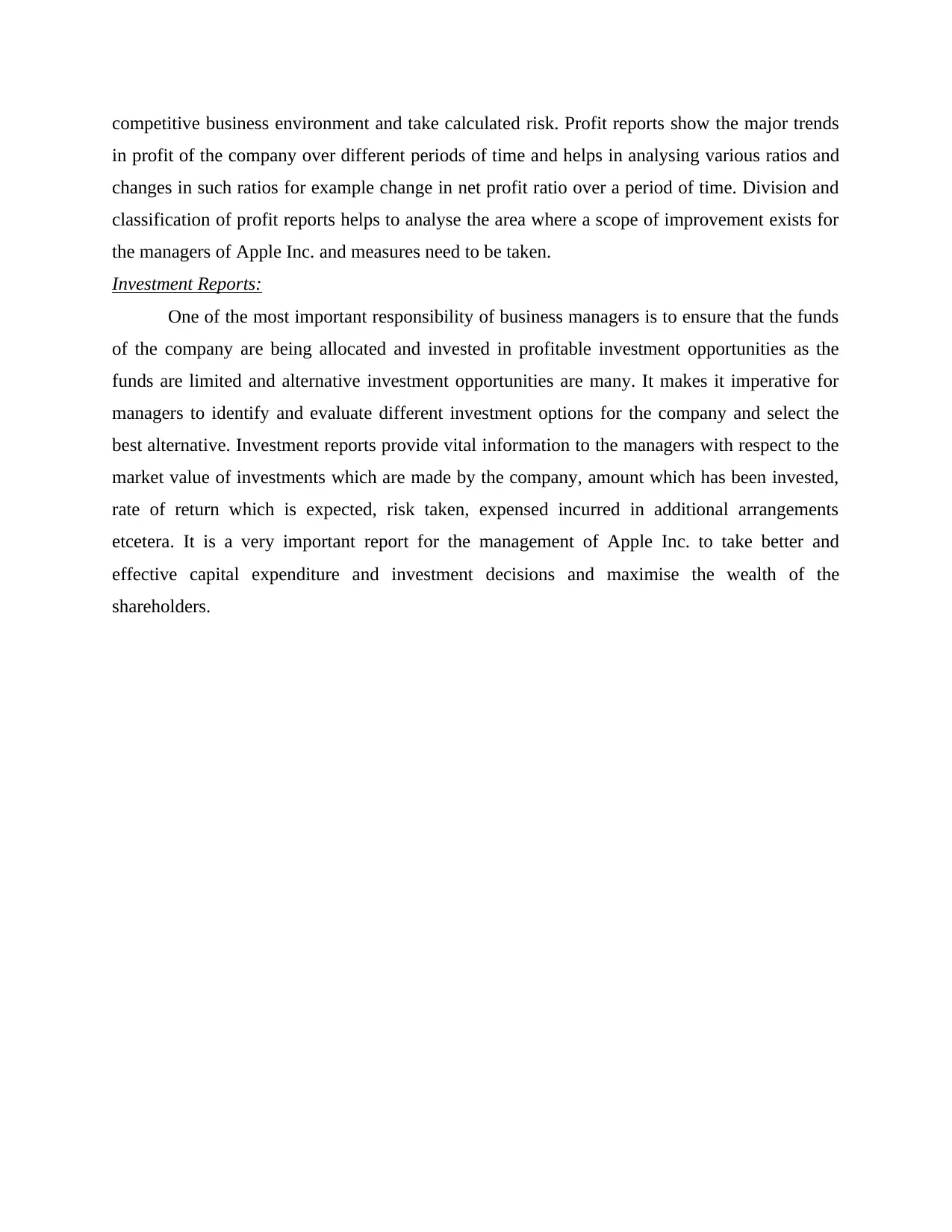
competitive business environment and take calculated risk. Profit reports show the major trends
in profit of the company over different periods of time and helps in analysing various ratios and
changes in such ratios for example change in net profit ratio over a period of time. Division and
classification of profit reports helps to analyse the area where a scope of improvement exists for
the managers of Apple Inc. and measures need to be taken.
Investment Reports:
One of the most important responsibility of business managers is to ensure that the funds
of the company are being allocated and invested in profitable investment opportunities as the
funds are limited and alternative investment opportunities are many. It makes it imperative for
managers to identify and evaluate different investment options for the company and select the
best alternative. Investment reports provide vital information to the managers with respect to the
market value of investments which are made by the company, amount which has been invested,
rate of return which is expected, risk taken, expensed incurred in additional arrangements
etcetera. It is a very important report for the management of Apple Inc. to take better and
effective capital expenditure and investment decisions and maximise the wealth of the
shareholders.
in profit of the company over different periods of time and helps in analysing various ratios and
changes in such ratios for example change in net profit ratio over a period of time. Division and
classification of profit reports helps to analyse the area where a scope of improvement exists for
the managers of Apple Inc. and measures need to be taken.
Investment Reports:
One of the most important responsibility of business managers is to ensure that the funds
of the company are being allocated and invested in profitable investment opportunities as the
funds are limited and alternative investment opportunities are many. It makes it imperative for
managers to identify and evaluate different investment options for the company and select the
best alternative. Investment reports provide vital information to the managers with respect to the
market value of investments which are made by the company, amount which has been invested,
rate of return which is expected, risk taken, expensed incurred in additional arrangements
etcetera. It is a very important report for the management of Apple Inc. to take better and
effective capital expenditure and investment decisions and maximise the wealth of the
shareholders.
Paraphrase This Document
Need a fresh take? Get an instant paraphrase of this document with our AI Paraphraser
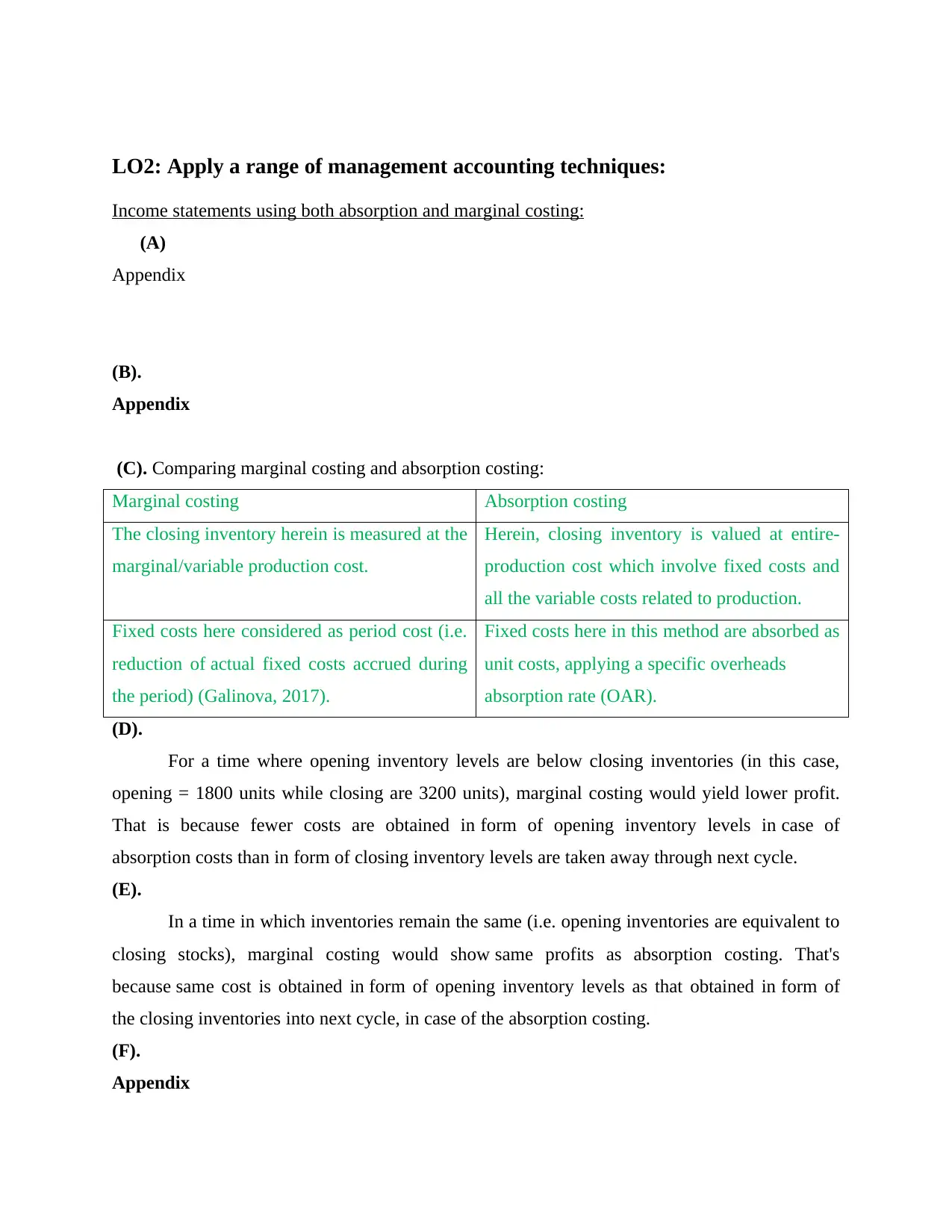
LO2: Apply a range of management accounting techniques:
Income statements using both absorption and marginal costing:
(A)
Appendix
(B).
Appendix
(C). Comparing marginal costing and absorption costing:
Marginal costing Absorption costing
The closing inventory herein is measured at the
marginal/variable production cost.
Herein, closing inventory is valued at entire-
production cost which involve fixed costs and
all the variable costs related to production.
Fixed costs here considered as period cost (i.e.
reduction of actual fixed costs accrued during
the period) (Galinova, 2017).
Fixed costs here in this method are absorbed as
unit costs, applying a specific overheads
absorption rate (OAR).
(D).
For a time where opening inventory levels are below closing inventories (in this case,
opening = 1800 units while closing are 3200 units), marginal costing would yield lower profit.
That is because fewer costs are obtained in form of opening inventory levels in case of
absorption costs than in form of closing inventory levels are taken away through next cycle.
(E).
In a time in which inventories remain the same (i.e. opening inventories are equivalent to
closing stocks), marginal costing would show same profits as absorption costing. That's
because same cost is obtained in form of opening inventory levels as that obtained in form of
the closing inventories into next cycle, in case of the absorption costing.
(F).
Appendix
Income statements using both absorption and marginal costing:
(A)
Appendix
(B).
Appendix
(C). Comparing marginal costing and absorption costing:
Marginal costing Absorption costing
The closing inventory herein is measured at the
marginal/variable production cost.
Herein, closing inventory is valued at entire-
production cost which involve fixed costs and
all the variable costs related to production.
Fixed costs here considered as period cost (i.e.
reduction of actual fixed costs accrued during
the period) (Galinova, 2017).
Fixed costs here in this method are absorbed as
unit costs, applying a specific overheads
absorption rate (OAR).
(D).
For a time where opening inventory levels are below closing inventories (in this case,
opening = 1800 units while closing are 3200 units), marginal costing would yield lower profit.
That is because fewer costs are obtained in form of opening inventory levels in case of
absorption costs than in form of closing inventory levels are taken away through next cycle.
(E).
In a time in which inventories remain the same (i.e. opening inventories are equivalent to
closing stocks), marginal costing would show same profits as absorption costing. That's
because same cost is obtained in form of opening inventory levels as that obtained in form of
the closing inventories into next cycle, in case of the absorption costing.
(F).
Appendix

LO3: Explain the use of planning tools used in management accounting:
P4. Advantages and disadvantages of different types of planning tools used in budgetary control:
Budget is financial framework for coming financial year. The budget is projection and estimation
of all revenues and expenditures. It is financial report that summarize past/prior period financial
experiences and show an existing plan in coming future for specified time period (Grabner,
Posch and Wabnegg, 2018). This promotes strategic control and cooperation, as it integrates the
various policy operations into single plan.
Objective of Budgeting: Planning is certainly is budgeting's most obvious aims. That it helps an
entity to measure the profits and costs from an earlier time and afterwards predict
where service/process could be in future, for example, it may help Apple to add or exclude
products and services which satisfy the company's anticipated demand during the timeframe.
Types of Budgets: Here following is discussion above different sort of Budgets in context of
Apple, as follows:
Incremental budget: Incremental budget is essential aspect of managerial accounting focused
on the principle that to arrive at the current budget a minor adjustment is made to existing
budgets. In attempt to reach at the current budgeted figures only incremental amounts/sums are
incorporated (Horvat and Mojzer, 2019).
Advantages: This budgeting approach is pretty simple to incorporate, which does not require any
complicated computations. This could be accomplished without much problem for different
departments/units as one doesn't require any thorough analysis regardless of the unit being
considered.
Disadvantages: Since the system presupposes a minor adjustment to the previous cycle of
budgeting allocations, it means that working process stays the very same. This could result in
lacks of innovation and therefore no incentives for executives to cut costs (Kostyukova and et. al,
2018).
Zero based budget: A Zero-based budgeting involves making up budget with zero-base from
zero/scratch. It includes re-evaluating each line items of cash-flow statements and explaining all
of cost the department would incur.
P4. Advantages and disadvantages of different types of planning tools used in budgetary control:
Budget is financial framework for coming financial year. The budget is projection and estimation
of all revenues and expenditures. It is financial report that summarize past/prior period financial
experiences and show an existing plan in coming future for specified time period (Grabner,
Posch and Wabnegg, 2018). This promotes strategic control and cooperation, as it integrates the
various policy operations into single plan.
Objective of Budgeting: Planning is certainly is budgeting's most obvious aims. That it helps an
entity to measure the profits and costs from an earlier time and afterwards predict
where service/process could be in future, for example, it may help Apple to add or exclude
products and services which satisfy the company's anticipated demand during the timeframe.
Types of Budgets: Here following is discussion above different sort of Budgets in context of
Apple, as follows:
Incremental budget: Incremental budget is essential aspect of managerial accounting focused
on the principle that to arrive at the current budget a minor adjustment is made to existing
budgets. In attempt to reach at the current budgeted figures only incremental amounts/sums are
incorporated (Horvat and Mojzer, 2019).
Advantages: This budgeting approach is pretty simple to incorporate, which does not require any
complicated computations. This could be accomplished without much problem for different
departments/units as one doesn't require any thorough analysis regardless of the unit being
considered.
Disadvantages: Since the system presupposes a minor adjustment to the previous cycle of
budgeting allocations, it means that working process stays the very same. This could result in
lacks of innovation and therefore no incentives for executives to cut costs (Kostyukova and et. al,
2018).
Zero based budget: A Zero-based budgeting involves making up budget with zero-base from
zero/scratch. It includes re-evaluating each line items of cash-flow statements and explaining all
of cost the department would incur.
⊘ This is a preview!⊘
Do you want full access?
Subscribe today to unlock all pages.

Trusted by 1+ million students worldwide
1 out of 26
Related Documents
Your All-in-One AI-Powered Toolkit for Academic Success.
+13062052269
info@desklib.com
Available 24*7 on WhatsApp / Email
![[object Object]](/_next/static/media/star-bottom.7253800d.svg)
Unlock your academic potential
Copyright © 2020–2025 A2Z Services. All Rights Reserved. Developed and managed by ZUCOL.




